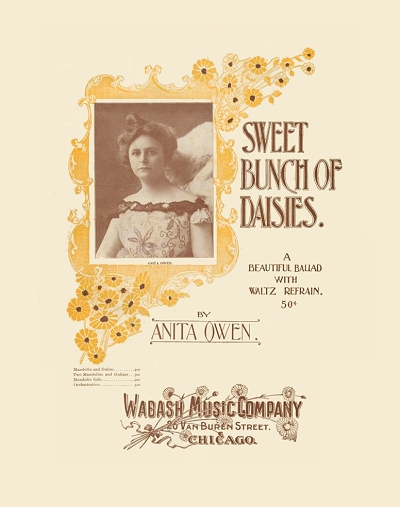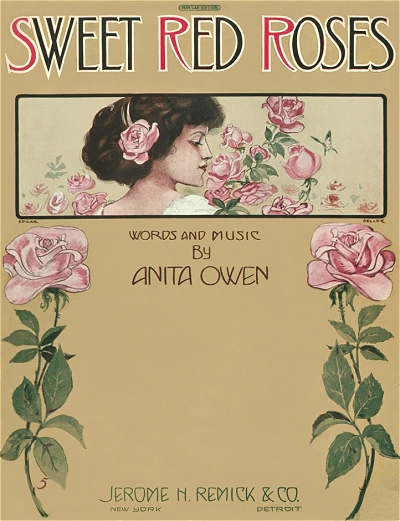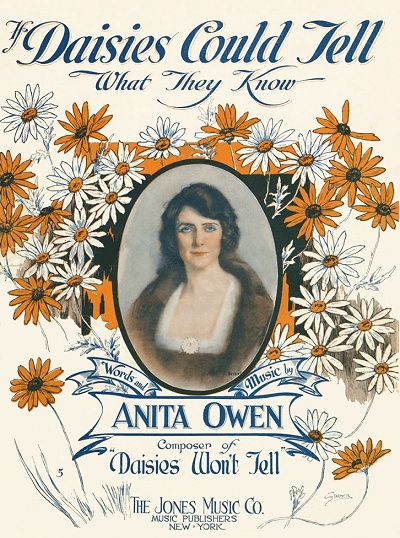Anita Owen was born in Brazil, Indiana, near Terre Haute, to Welsh immigrant John Dale Owen and his Indiana-born wife Louisa Hughes. She had only one sibling, Morton D. (4/1880). John was a Welsh music teacher and composer, although he appears to have published virtually nothing in the United States. Louisa was a niece of English composer Sir Thomas Hughes. So music certainly was present at a respectable level in this family, even though she claimed in later interviews to have had little actual musical training as a girl. For the 1880 census John was listed as a traveling salesman. Terre Haute directories of the late 1880s into the late 1890s show that he was working as a piano tuner and Morton as a musician, although he would eventually follow in his father's career track, working as a piano tuner for a music store in Bloomington, Indiana.
Anita was boarded and educated at the Convent of St. Mary of the Woods in Terre Haute, and between the school and her father was sufficiently trained in music composition, harmony and theory, and piano performance. It is likely she was there for the 1880 census, as were many young girls aged 2 to 14, but cannot be pinpointed owing to a lack of clarity on that record. Given the demographics of that enumeration, Anita would have left the school in the mid to late 1880s.
According to her obituary Anita sold her first song at age 15 or 16 for a mere $5. The title of the piece is unclear due to shifting copyright dates, but it was stated, logically, as an Ave Maria type of song. Following that point, her story of her rise to fame for one of her next pieces, and subsequent early pitfalls was told in an article in The San Francisco [California] Sunday Call in their November 20, 1910, edition, opening up an article about women composers:
Once there a young convent girl whose finger tips tingled with a catchy melody, while sentimental verses ran through her head keeping tune with the elusive air. She wrote the verses, set them to the melody her finger tips unconsciously played, published the song herself and made one of the most remarkable successes that a writer of popular lyrics and scores ever has made.

Incidentally, she amassed a fair sized fortune — at least it seemed large to the practically penniless girl, for it fell only a little short of the hundred thousand dollar mark, and the royalties from this bit of musical sentiment are still making her purse bulge comfortably as the quarterly checks come in.
This is what it means to write a popular song. It means wealth, successes and being sought after by publishers of music, and fame as well, even though it be limited to the vaudeville and the hurdy gurdy circuits.
Since the convent girl's achievement other women have composed popular songs, and those who are known to the public as well as to the publisher receive handsome checks for what seems to the outside world only a few hours' work — merely the dashing off of a dozen or so melodious bars of music and fitting to them a set of verses bubbling over with sentiment or having a stirring swing...
The convent girl lived in Chicago when she made her fame and fortune with "Sweet Bunch of Daisies." That was 14 or 15 years ago, and the composer, Miss Anita Owen, is still drawing an income from the song, which cost her less than $50 to place on the market. Recently Miss Owen moved to New York and allied herself with a music publishing house, agreeing to furnish ten songs a year for which she is to write the lyrics and scores. That is less than an average of a song a month, and the publishers do not expect, greedy as they are for real successes, to have all ten reach the high water mark of sales, which is one hundred thousand copies of a song. But at least some, of them must have a run which is helped on to success by the whistling public and the ubiquitous hand organ. And her yearly guarantee is much larger than what the average professional woman earns...
Since this 16 year old girl launched "Sweet Bunch of Daisies" in Chicago, attending to the printing of the music, designing, the title page and the placing of the song on the market, it has sold about one million copies. In those days the composer's profits amounted to [optimistically] 10 cents a copy, but since those days the prices of sheet music have gone down and the composer's profits have gone with them, so that two cents a copy is considered a fair profit to be handed over by the publisher to the lyric and melody writer.
"My friends tried their best to persuade me to let some music publishing house handle my first song, but I was determined to look after the business end myself," said Miss Owen the other day. "What did I, a girl of 16, know of publishing music? Nothing at all, and now I marvel at my courage. But the success of the song was in no way due to its launching. It sold in spite of, rather on account of, my efforts.
"By the end of the first year checks began to come in so fast that I could not keep count of them, and as soon as I had an armful, I converted them into gold, which I kept stored in a vault in a bank. My convent head soon became turned by all this money and I rushed into all sorts of extravagances. I bought French gowns by the half dozen, had a maid and my own carriages, traveled wherever I wanted to, and felt like a Cinderella who had suddenly been released from the brown convent walls and got all the money she wanted to spend and told to enjoy herself. I did enjoy every cent of my wealth, and it all seemed just like a fairy tale to find that I suddenly began to have a steady income of from ten to fifteen thousand a year, when a year before I had no money at all.
"But you can not live always on the proceeds of one popular song," said Miss Owen. "Not when you spend your earnings as I did, and after I had had all the fun and the dresses and the traveling I wanted I took up my pencil and paper again and sat at the piano hours at a time setting other words to the music which ran through my head. But the 'Sweet Bunch of Daisies' had cut out a path which I had to follow to please my publishers, for they called me the writer of flower songs, and whenever I brought in something that had no mention of roses or daisies or pansies — some sentimental flower — they looked disappointed. One of my favorite songs, the 'lnvitation Waltz Song,' was written for and sung by Marie Van Studdiford, but it has never reached the popularity of my first attempt."

Before she was even out of her teens, Anita worked to become established as a serious composer. With the help of her father she set up the Wabash Music Company in order to publish and distribute her early works. Sweet Bunch of Daisies was, by some accounts, a record breaker in the 1890s, particularly for a woman, having sold over one million copies within a fifteen years of its 1894 publishing debut. Anita's affinity for flowers or floral music, as many of her subsequent works would be about daisies or roses, was obviously challenged by her own words. However, Owens' interest in the floral subjects that she wrote on eventually extended into her daily life as well. According to an article in the Music Trade Review in 1910:
Miss Owen, who has made a fortune writing flower songs, has a conservatory containing a profusion of beautiful floral plants adjoining the music room of her home, and the fragrance of sweet flowers permeates and fills the air when she composes.
Early on Anita wrote with popular lyricist Arthur J. Lamb and two others, but soon found she had a talent with lyrics as well, so all of her songs composed 1900 and later included her own lyrics. She also composed several instrumentals, including marches, waltzes, intermezzos, and one popular cakewalk in 1899, Dance of the Collywobbles, published under the Wabash logo. The title refers to a phrase used to indicate intestinal disorder or an upset stomach. As of the 1900 census, Anita was living in south Chicago, Illinois, listed as a song composer. She had also acquired an assistant who stayed with her for over a dozen years, Hattie Von Bulow, who was listed as Anita's private secretary in public records including the census. Nothing further was found on the personal aspect of their relationship. Hattie appears to possibly have been related to musician Dr. Hans Von Bulow, and either of them may have arranged and fingered some of her works.
A number of Anita's songs found their way to the stage in the first decade of the century, including a clever tune called Sweet Sally O'Malley and another Irish-themed number, Ellen O'Hagen. She also completed and copyrighted The Great Mogul (some sources mistakenly have The Grand Mogul), "A Romantic Comic Opera in Three Acts," in 1903. According to various accounts in trade and New York newspapers, The Great Mogul was successfully produced and staged a number of times. A copy of the entire work still exists on microfilm at the University of Missouri, Columbia, and assumedly at the Library of Congress.
The reason for the dual naming of the work is the result of an alleged piracy. At one run in 1906 at the Colonial Theater in Chicago, its legitimacy was called into question. According to an article from December 22, 1906:
Suit for an accounting on the ground that 'The Grand Mogul,' now showing at a local theatre, was pirated from 'The Great Mogul,' an opera by Miss Anita Owen, was filed in [Chicago] circuit court yesterday by Attorney H. J. Toner on behalf of Miss Owen... Miss Owen alleges that she submitted her production to Mr. [Frank] Moulan and Mr. [Herbert] Gresham a year after it was copyrighted in 1903, and that it was rejected. Afterward, according to the allegations in her petition, Messrs. [Frank] Pixley [lyricist] and [Gustav] Luders [composer] were commissioned by Klaw and Erlanger to build an opera on the ideas obtained from her manuscript, and the result was produced as 'The Grand Mogul.'
The defendants denied the charges, with Pixley claiming he had written his plot as early as 1900. The outcome of the trial was not found in the author's research.

By mid-decade Anita and Hattie had moved to Manhattan, New York. In early 1908 publisher Jerome H. Remick bought Wabash Music and in doing so acquired not only the catalog of Anita's works, but the composer as well. For the next several years most of her works were published by Remick. After a number of moderate hits she found her stride again with a 1908 best seller, Daisies Won't Tell, one of the most popular "daisy" songs of all time. The instrumental intermezzo Fire Fly also did well and was recorded on cylinder along with some of her "daisy" tunes. Remick had an agreement with her to compose several semi-classical compositions for their "Library Edition" which targeted both artists and music teachers.
The 1910 enumeration showed Daisy and Hattie in Manhattan with Daisy now listed as a music playwright, although no works have been found specifically composed for Broadway by Miss Owen. It is not known when Hattie moved on, but the last listing found for her with Anita is 1911 in the Manhattan city directory. The 1913 Manhattan city directory is the last in which Anita appeared. She may have moved around this time up to Bridgeport, Connecticut, continuing her work from there through the mid-1910s.
On February 27, 1917, Anita was married to a Bridgeport dentist who was raised in New Hampshire, Dr. Arthur J. Jones. The ceremony was held at The Little Church Around the Corner on East 29th in Manhattan. Anita continued to compose under her maiden name, quite heavily for at least another three years, with a particularly long list of works published in 1919. It was reported in an article planted by Jones that the Jones Music Company of New York, which was started by her husband, claimed that they had engaged Owen, "the daisy songwriter," for three waltz songs at the paid sum of $30,000. Some of those listed above for 1919 were likely included in that group. There were predictions about a bright future for the aging writer in the wake of her resistance to jazz music.
While in reality none of the works captured her previous success, they still saw fairly good sales under both the Jones and Remick logos. One interesting instrumental was a fox trot from 1920, Alla, dedicated to "The Famous Artiste and Metropolitan Star, Mme. Alla Nazimova." It was one of her only works in this particular dance genre but sold very well at its debut.
The Joneses seem to have evaded the enumerated taken 1920 census in spite of deep searches on variations of their collective names. Now in her late forties, Anita appears to have quit composing, or at least publishing her works, retiring from music. It is known that the couple relocated to from Bridgeport to New Haven, Connecticut around 1923. As of the 1930 census, Arthur was listed as a commercial salesman for wholesale dental supplies, while Anita no longer showed any occupation. In 1932 Anita Owen Jones died at St. Raphael's Hospital in New Haven after a short bout of pneumonia, just before her 58th birthday.

 Compositions
Compositions